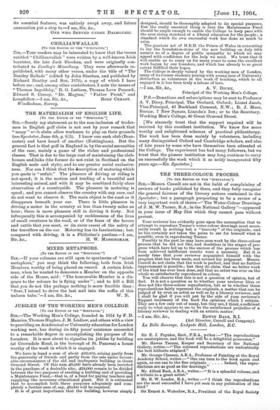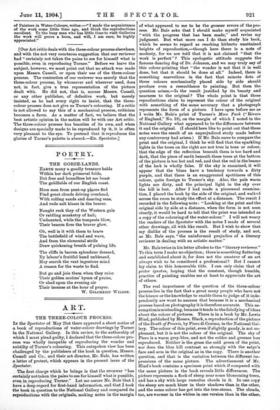[To TEE EDITOR OF TUE "SPECTATOR."] SIE, — MRSRFS. Cassell are not
in the habit of complaining of reviews of books published by them, and they fully recognise the genes-al fairness of the literary notices contained in the Spectator; but a paragraph purporting to be a review of a very important work of theirs—" The Water-Colour Drawings of J. M. W. Turner, R.A., in the National Gallery "—appeared in your issue of May 21st which they cannot pass without protest.
Your reviewer has evidently gone upon the assumption that to attempt to reproduce Turner's water-colour drawings must neces- sarily result in nothing but a " travesty " of the originals ; and he has certainly not taken the pains to see for himself what is possible, even in reproducing Turner.
Possibly in the past he may have seen work by the three-colour process that he did not like, and doubtless in the stages of pro- gress which have led up to the success of the process which has been achieved indifferent results were a necessity. But it is surely time that your reviewer acquainted himself with the progress that has been made, and revised his judgment. Messrs. Cassell do not claim that the work is perfect, and that no further improvement is possible ; but they do claim that no better work of the kind has ever been done, and that no artist was ever on the whole so satisfactorily reproduced in colour.
You will observe that this is not a question of opinion, but of fact. It is not a question as to whether your reviewer likes or does not like three-colour reproduction, but as to whether these reproductions fairly represent the originals, a matter that can be judged of by even an artist as well RR by a literary reviewer, and I shall be glad if you will put by the side of your reviewer's flippant treatment of the book the opinions which I subjoin. They are a few only out of many, but they are, I think, a sufficient reply to what appears to me to be the uninformed prejudice of a literary reviewer in dealing with an artistic matter.
—I am, Sir, &c., EDWIN BALE, R.I.
Sir E. Y. Poynter, Bart., P.E.A., writes :—" The reproductions are masterpieces, and the book will te a delightful possession."
Mr. Hawes Turner, Keeper and Secretary of the National Gallery, writes :—"The coloured reproductions are undoubtedly the best hitherto attained."
Mr. George Clausen, A.R.A., Professor of Painting at the Royal Academy School, writes :—" One can turn to the book again and again, as one can to the fine originals Indeed, the repro- ductions are as good as the drawings."
Mr. Alfred East, A.K.A., writes:—" It is a splendid volume, and a tribute to a great artist."
Mr. B. W. Leader, RA., writes :—" I think the reproductions are the most successful I have yet seen in any publication of the kind."
Sir Ernest A. Waterlow, RA., President of the Royal Society.
of Painters in Water-Colours, writes :—" I made the acquaintance of the work some little time ago, and think the reproductions excellent. To the busy man who has little time to visit Galleries the work will prove a boon, and will, I am sure, be highly appreciated."
[Our Art Critic deals with the three-colour process elsewhere, and with the not very courteous suggestion that our reviewer had "certainly not taken the pains to see for himself what is possible, even in reproducing Turner." Before we leave the subject, however, we must point out that no attack was made upon Messrs. Cassell, or upon their use of the three-colour process. The contention of our reviewer was merely that the three-colour process, by whomever and wherever used, does not, in fact, give a true representation of the picture dealt with. He did not, that is, accuse Messrs. Cassell, or any other publisher, of defective work, but merely insisted, as he had every right to insist, that the three- -colour process does not give us Turner's colouring. If a critic is not allowed to say this of a mechanical process, criticism becomes a farce. As a matter of fact, we believe that the best artistic opinion in the nation will be with our Art critic. The three-colour process has beauties of its own, and when designs are specially made to be reproduced by it, it is often very pleasant to the eye. To pretend that it reproduces the glories of Turner's palette is absurd.—ED. Spectator.]











































 Previous page
Previous page